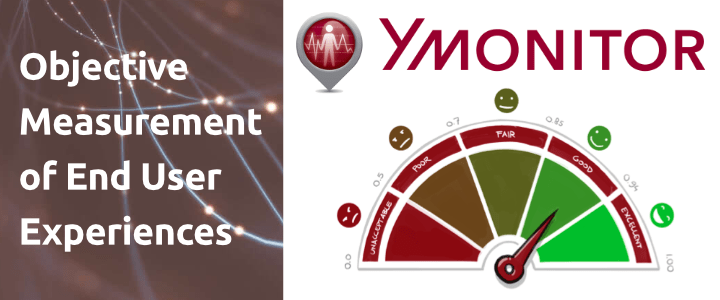Objective Measurement of End user Experiences using Ymonitor

Sadly, it is not uncommon for IT incidents to be spotted first by end-users rather than IT monitoring. Poor availability and slow performance of an application result in frustration among end-users; they reduce user productivity and can cause damage to your brand or result in loss of revenues. Using Ymonitor synthetic monitoring, you can stay one step ahead of your users and detect problems before users start calling the help desk.
How does it work?
In order to objectively analyse the performance of your application, Ymonitor measures from the end-users’ perspective. It takes measurements from multiple locations, both from outside the data centre to replicate an end-user, and inside the data centre to isolate where within the IT stack a problem occurs. For example, you might continually simulate a user opening an application, navigating to a particular screen and placing an order so that the availability and performance of the end-to-end process can be determined. The results of these measurements could then be displayed on a personalised dashboard. If the performance degrades or the application becomes unavailable, this would then be displayed immediately on the dashboard, and an alert could also be generated.
Who is it for?
End-user monitoring is typically deployed by a technical administration or IT operations department. But different teams can then benefit from the data it provides. That could be application owners or service managers responsible for a specific application. Or it could be an infrastructure team who need to know that their particular piece of the user journey is healthy. Depending on the level of detail required, individuals might choose to receive real time alerts or they may just need access to the status dashboard or weekly PDF reports.
What are the benefits?
With Ymonitor, you can monitor your key applications and spot any faults quickly before they become major incidents. Once you start gathering data you can analyse trends over time to see correlations, such as the impact of a new release or fix, the effect of adding more users or the effects of other changes to your IT environment. The data can also be used to track Service Level Agreements (SLAs) on uptime, or eXperience Level Agreements (XLAs) on end-user experience measures. Ymonitor prevents incidents and reduces the Mean Time to Repair (MTTR) when things do go wrong.
Who uses it?
Dutch Railways
Ymonitor is used by Dutch Railways who continually check that their key business applications delivered through Citrix virtual workstations are available and performing well. Due to the nature of Citrix, simulating end user activities is not trivial but Ymonitor works well in these environments. If response times do increase, these are detected immediately, and costly incidents can be avoided.
Eneco
Ymonitor has been working with Dutch energy provider Eneco for many years. Initially it began by targeting performance monitoring for specific applications, but that has since developed into performance management for Eneco’s entire IT landscape. Eneco also use our WebTuna Real User Monitoring solution which gives them both real usage and the steady baseline measurement that you get from synthetic monitoring.
If you’d like to discuss End User Experience measurement, then please get in touch with one of our experts and let’s discuss your challenges.
